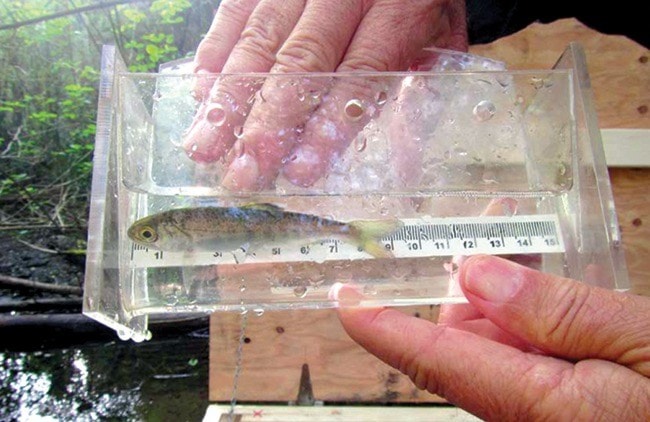The record hot dry weather this year is affecting many things, including local salmon smolt numbers.
The Mid-Vancouver Island Habitat Enhancement Society (MVIHES) has done a lot of restoration and studies of local waterways, and their recent
16-page report on smolt counts in Parksville's Shelly Creek hides some good news.
"The smolt production in Shelly Creek is still very good, but the report shows that we still have to be careful and there's lots more to be done," said report author Barb Riordan, a MVIHES volunteer with a background in biology.
A total of 1,708 fish were captured in a "V-weir" trap over five weeks in April and May, of which 1,247 were coho smolt. No trout were caught, though cutthroat and rainbow were seen in previous counts.
This year's count found about a sixth the smolt of the last count in 2013, and the least by far of the four counts done to date.
MVIHES project coordinator Faye Smith said the numbers were low due to the record warm dry weather early this year, but all indications are that the creek is an increasingly important overwintering location for salmon.
The organization has been observing and working on the small creek, which runs through the southeast corner of Parksville and empties into the Englishman River, since at least 1999 when they did their first formal assessment.
A repeat of that assessment in 2014 found "concerning results," including half as many pools, less cover for fish and a lot of erosion and sediment issues, according to the MVIHES website.
Based on the study they received a $47,000 grant from the Department of Fisheries and Ocean's Recreational Fisheries Conservation Partnerships Program, which Smith said they were able to double with various other matching grants.
This summer MVIHES and various partners, including the City of Parksville and Regional District of Nanaimo, did some major restoration to clean and stabilize the creek for fish passage.
Riordan said beaver dams were another factor in this year's low count, trapping smolt in the high reaches after the warm dry spring dropped water levels early.
"Dead and distressed smolt were observed behind two beaver dams at the time of trap retrieval," Riordan said, suggesting something would have to be done, like installing pipes to allow fish access.
The count may also have been done too late, the report says, pointing to water temperatures of 8.5 C or warmer being key, which Shelly Creek reached three weeks before the count.
"The impressive results of this count may be hidden," Smith admitted about the low numbers, explaining the existence of the smolt at all was impressive under the poor conditions, highlighting the importance of the creek to the salmon life-cycle.
Riordan's report concludes that "Shelly Creek remains an important waterbody for trout and coho salmon and should be protected from the impacts of development and urbanization," calling for another count in 2016.
Smith said their goal now is to find the funding and partners for a much larger, three-year restoration project.
Visit www.mvihes.bc.ca for more information.
